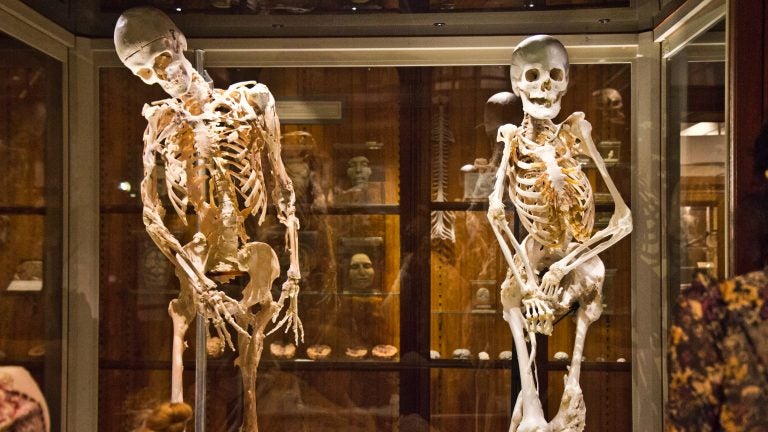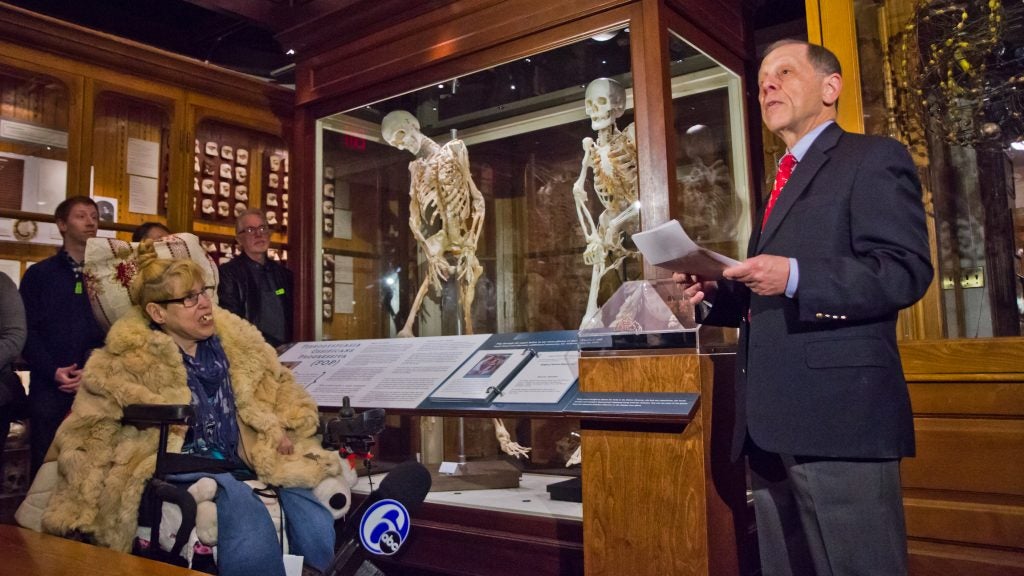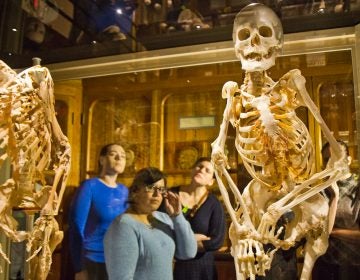Why did the Mütter Museum take down all their YouTube videos and online exhibits?
There has been an ongoing, broader discussion around displaying human remains, which has brought up some difficult questions many institutions are grappling with.
Listen 7:04
The skeletons of Harry Eastlack (left) and Carol Orzel on display at the Mütter Museum in Philadelphia. (Kimberly Paynter/WHYY)
Robert Pendarvis gave his heart to Philadelphia’s Mütter Museum. Literally.
He has a rare condition called acromegaly, where his body makes too much growth hormone, which causes bones, cartilage and organs to keep growing. The condition affected his heart, so much so that a heart valve leaked. He had a heart transplant in 2020.
Pendarvis thought his original heart could tell an important story, and teach others about this rare condition, which is why he was determined to put it on display at the Mütter Museum.
The Mütter Museum is a Philadelphia institution, a medical museum that draws hundreds of thousands of visitors to its rooms filled with anatomical specimens, models, and old medical instruments. The place is not for the squeamish. Display cases show skulls, abnormal skeletons, and a jar containing the bodies of stillborn conjoined twins.
Pendarvis thought it would be the perfect home for his heart — and more.
“I wanted to give my skeleton if I died because of the acromegaly information that they have at the museum. That was what was important,” he said.
A curator at the museum interviewed him and put a video about him and his old heart on their YouTube channel. Pendarvis still sees doctors regularly, and whenever he meets a new healthcare provider, he shows them the video as a way of explaining his complex health history.
But a few months ago, he noticed that the video had disappeared without a trace.
“It’s a little frustrating because I use Mütter museum’s website … to tell practitioners and nurses about me.”
And beyond doctors and nurses, he said people in the patient community know about him because of the Mütter Museum’s video of his heart, which is exactly what he had in mind when he made his donation.
“I did have to sign legal paperwork saying it belonged to them so they could do what they want to do with it. But for them to bury it in their archives so soon after I gave it to them would really be an injustice.”
And it appears that the museum itself has had a change of heart about its role, what it presents and how. It’s not just Pendarvis’ video that has vanished: all of the museum’s online exhibits and YouTube videos are gone. The Mütter Museum’s YouTube channel has more than 100,000 subscribers.
There has been an ongoing, broader discussion in the museum world around displaying human remains, which has brought up some difficult questions many institutions are grappling with.
Kate Quinn, the new executive director of the Mütter Museum, explained that the online content has been removed because the museum is reviewing all of it to think about how to ethically and responsibly present the collection.
“(Pendarvis’ heart) is still on display. His story is still on display in the museum physically. It’s just temporarily removed from our online presentation,” she said. “I don’t have reason to believe that it won’t come back up. But until we have these wider discussions, I can’t say that for sure.”
She said the collection involves people who are no longer living, and had values that may differ from what people now believe. She also said while some people clearly consented to be in the collection, others did not, so the museum has to think about how to handle those cases.
She said the museum is surveying people for their feedback. She said there are many who love the museum, but points out there are also people who find it gross and choose not to come back, citing TripAdvisor reviews.
“For any other museum, would there be a question as to whether or not you should eat after you have your visit? What are we doing here that’s causing people to have that recommendation?”
The average rating for the museum on TripAdvisor is 4.5 out of 5.
Quinn said she doesn’t know how long it will take for the Mütter to decide which online exhibits and videos will be restored.
Dr. Mira Irons is the CEO of the College of Physicians of Philadelphia, which runs the Mütter Museum. She said the decision to take down all their online exhibits and videos is an effort to “make sure that our online presence is respectful and that it’s appropriate.”
Irons came on board two years ago. When asked what respectful means in this context, she said it is hard to describe, but that there will be a group of experts to review the museum’s online exhibits and videos.
She said when physicians look at the specimens, they see patients, and “we can contextualize the stories of those patients in our minds as we’re going through it. It’s kind of natural for us.”
For other museum visitors, that holistic view may be more elusive, she said.
“Unless you have that subject matter expertise to contextualize yourself somewhat, we just have to do it for you. And it’s not hard, but I think it’s an extra step, and I think it’ll make the experience better,” she said.
She said this is what the museum needs to do: include more of the context so that laypeople, just like physicians, can see that the specimens are people, not objects.
But photographer Anne Hoskins says that is precisely what the museum is already doing. She’s a fan and frequent visitor to the museum.
“As someone who grew up in a strong religious community … it feels like church,” she said. “There is a quality of reverence that is really apparent. And I think it’s nearly impossible for anyone, any layperson in particular, to walk inside and really pay attention and walk out of that place unchanged.”
She is not pleased with the museum’s decision to take down all online exhibits and videos.
Robert Hicks, former director of the Mütter Museum, said people do not see the Mütter like other museums. He says they have deep, personal connections to this place, and its displays.
“Let’s say … Philadelphia Museum of Art: world famous, huge art collection, huge museum. They may take something off display. They may close down a wing for a while to maybe renovate. They may get a few complaints, but you don’t have people coming to the fore to say, ‘that’s my museum. You’re taking down something that has a personal meaning to me. I want to see it back up.’ And yet that’s the kind of audience the Mütter has. People of all kinds feel a very strong personal resonance with the museum.”
He added that the museum has always thought about how to ethically present human specimens with the proper context.
“One ethos that the museum has been very strong about is: there’s no division between what constitutes a normal body and an abnormal one. There’s a continuum of phenomena, but we’re all normal. A person who has terminal cancer is still a normal human being.”
As an example, he brings up Carol Orzel. Like Robert Pendarvis, she wanted to be on display at the museum. She had a rare condition where her muscles and tendons turned into bone. She grew a second skeleton, eventually making it hard for her to move.
“She would go to medical schools and say, ‘here is me. This is what I’ve got. I know what it means. I know it means an early death … I am here to help educate you. But I also want you to know … I am an autonomous human being.'”
She died in 2018.
“She wore a lot of costume jewelry when she was in a disabled persons’ home, and she said, ‘I want the Mütter museum to put me on display for study so people can understand. You can have a life and have this kind of disabled body. But I want you to do me something extra: I love costume jewelry, and I wear it all the time. And I have a big collection. So you’re going to display my skeleton and you’re going to display my costume jewelry.'”

The museum has also repatriated human remains in the past. For instance, in 2017, the Australian Army asked for the remains of one of their soldiers from World War 1 to be reburied, and the museum did that. The Australian Army found out about this through Memento Mütter, one of the museum’s online exhibits, which the current management has removed.
The museum also continues to drive new research. For example, in 2014, researchers made a new discovery about cholera by studying the collection. Robert Hicks points out that was the first time researchers had been able to extract viable DNA from a specimen of a person who died from cholera. In this case, it was from someone who died of the disease in Philadelphia in 1849. There was further research published in 2021, also using specimens from the museum.
The current management has closed the museum off from research, starting May 9.
This is not the first time new management has decided to change the Mütter Museum’s image.
Back in 1996, new managers decided to cancel a popular photo calendar featuring specimens and other items from the museum’s collection. They explained their decision to the Philadelphia City Paper saying that it “smacks of the strange and bizarre.” Canceling the calendar led to significant backlash, including coverage in Time Magazine, where famous neurologist and writer Oliver Sacks commented that “there’s nothing improper or grotesque about it—and only a certain kind of immature or prurient mind would see these exhibits that way.” The new managers brought the calendar back a few years later.
Earlier this year, the College of Physicians of Philadelphia spent more than 9 million dollars to buy two historic buildings next to the museum. College CEO Dr. Mira Irons says they hope to build a campus, host events, and build new exhibits.
At the same time, around ten staff have left the college in the past seven months. That includes their director of development, who would have led fundraising.
Irons says that is just normal staff turnover during a transition.
Editor’s note: Since WHYY published this story on May 10, the Mütter Museum has updated their website to clarify that they have closed the collection to research in May 2022 for major renovations, and “look forward to welcoming researchers back in August 2023.”
WHYY is your source for fact-based, in-depth journalism and information. As a nonprofit organization, we rely on financial support from readers like you. Please give today.







